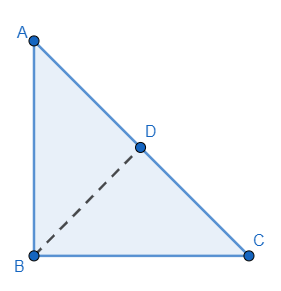
Prove that: In a right angled triangle, the square of the hypotenuse is equal to the sum of the squares of the other two sides.
Answer
591.3k+ views
Hint: Consider a right angled triangle ABC, right angled at B and construct a perpendicular to the side AC passing through B. Use the properties related to similarity of triangles to reach a result which might help you to conclude the mentioned statement.
Complete step-by-step answer:
First, we will draw a right angled triangle ABC, right angled at B and construct a perpendicular to the side AC passing through B.

Now in triangle ADB and triangle ABC , we have
Angle A is common between the two triangles, according to our construction $\angle ADB=\angle ABC=90{}^\circ $ . So, by AA similarity criteria, we can say that $\Delta ADB\sim \Delta ABC$ .
Now we know that the ratio of corresponding sides of two similar triangles is constant.
$\therefore \dfrac{AB}{AD}=\dfrac{AC}{AB}$
$\Rightarrow {{\left( AB \right)}^{2}}=AC\times AD..........(i)$
Now in triangle BDC and triangle ABC , we have
Angle B is common between the two triangles, according to our construction $\angle BDC=\angle ABC=90{}^\circ $ . So, by AA similarity criteria, we can say that $\Delta BDC\sim \Delta ABC$ .
Now we know that the ratio of corresponding sides of two similar triangles is constant.
$\therefore \dfrac{DC}{BC}=\dfrac{BC}{AC}$
$\Rightarrow {{\left( BC \right)}^{2}}=AC\times DC..........(ii)$
Now, if we add equation (i) and (ii), we get
${{\left( BC \right)}^{2}}+{{\left( AB \right)}^{2}}=AC\times DC+AC\times AD$
${{\left( BC \right)}^{2}}+{{\left( AB \right)}^{2}}=AC\left( DC+AD \right)$
Now from the figure, we can see that $DC+AD=AC$ . So, our equation becomes:
${{\left( BC \right)}^{2}}+{{\left( AB \right)}^{2}}=AC\times AC$
$\Rightarrow {{\left( BC \right)}^{2}}+{{\left( AB \right)}^{2}}={{\left( AC \right)}^{2}}$
So, we have proved that, in a right angled triangle, the square of the hypotenuse is equal to the sum of the squares of the other two sides.
Note: The main part in the above solution is the construction of the line BD. Also, it might be difficult to see the similar triangles in case of the above question. However, it is very important that you remember the Pythagoras theorem, as it is used in almost every question related to right angled triangles.
Complete step-by-step answer:
First, we will draw a right angled triangle ABC, right angled at B and construct a perpendicular to the side AC passing through B.

Now in triangle ADB and triangle ABC , we have
Angle A is common between the two triangles, according to our construction $\angle ADB=\angle ABC=90{}^\circ $ . So, by AA similarity criteria, we can say that $\Delta ADB\sim \Delta ABC$ .
Now we know that the ratio of corresponding sides of two similar triangles is constant.
$\therefore \dfrac{AB}{AD}=\dfrac{AC}{AB}$
$\Rightarrow {{\left( AB \right)}^{2}}=AC\times AD..........(i)$
Now in triangle BDC and triangle ABC , we have
Angle B is common between the two triangles, according to our construction $\angle BDC=\angle ABC=90{}^\circ $ . So, by AA similarity criteria, we can say that $\Delta BDC\sim \Delta ABC$ .
Now we know that the ratio of corresponding sides of two similar triangles is constant.
$\therefore \dfrac{DC}{BC}=\dfrac{BC}{AC}$
$\Rightarrow {{\left( BC \right)}^{2}}=AC\times DC..........(ii)$
Now, if we add equation (i) and (ii), we get
${{\left( BC \right)}^{2}}+{{\left( AB \right)}^{2}}=AC\times DC+AC\times AD$
${{\left( BC \right)}^{2}}+{{\left( AB \right)}^{2}}=AC\left( DC+AD \right)$
Now from the figure, we can see that $DC+AD=AC$ . So, our equation becomes:
${{\left( BC \right)}^{2}}+{{\left( AB \right)}^{2}}=AC\times AC$
$\Rightarrow {{\left( BC \right)}^{2}}+{{\left( AB \right)}^{2}}={{\left( AC \right)}^{2}}$
So, we have proved that, in a right angled triangle, the square of the hypotenuse is equal to the sum of the squares of the other two sides.
Note: The main part in the above solution is the construction of the line BD. Also, it might be difficult to see the similar triangles in case of the above question. However, it is very important that you remember the Pythagoras theorem, as it is used in almost every question related to right angled triangles.
Recently Updated Pages
Master Class 9 General Knowledge: Engaging Questions & Answers for Success

Master Class 9 English: Engaging Questions & Answers for Success

Master Class 9 Science: Engaging Questions & Answers for Success

Class 9 Question and Answer - Your Ultimate Solutions Guide

Master Class 12 Economics: Engaging Questions & Answers for Success

Master Class 12 Maths: Engaging Questions & Answers for Success

Trending doubts
Which places in India experience sunrise first and class 9 social science CBSE

Fill the blanks with the suitable prepositions 1 The class 9 english CBSE

Write the 6 fundamental rights of India and explain in detail

Difference Between Plant Cell and Animal Cell

What is pollution? How many types of pollution? Define it

What is the Full Form of ISI and RAW




